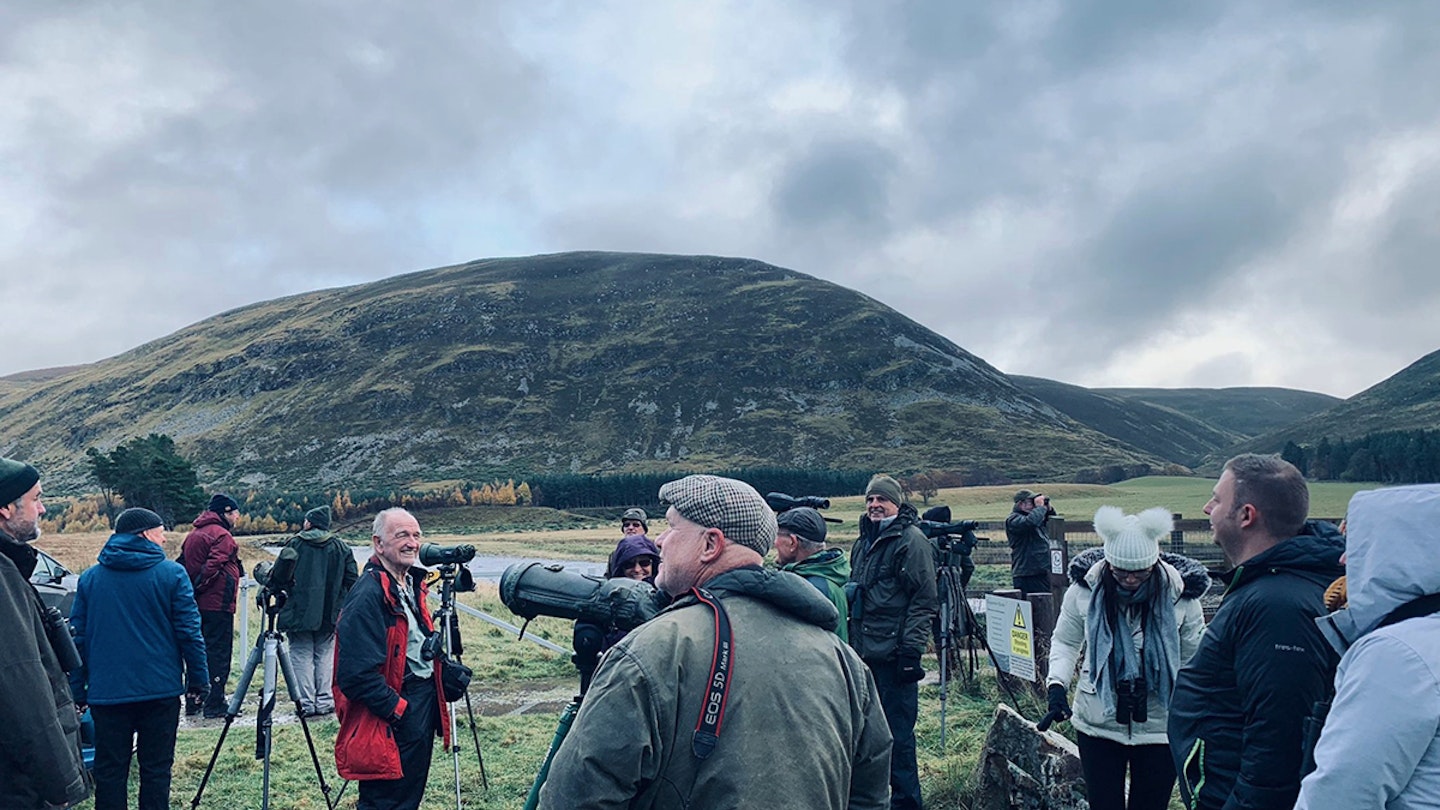For those of you who haven’t heard, the Grant Arms is up for sale, with the current owners retiring. The plan is to sell it as a going concern, and hopefully the new owners will keep the Wildlife Club going – it would be a ludicrous business decision to throw it all away. It is on offer for over £1.85 million if anyone wants to chip in.
We drove up on the Sunday, the rain never stopping throughout. There were some interesting white-out moments when we lost all vision due to the amount of spray being thrown up by lorries on the opposite carriageway.
We decided to change our itinerary and visit the Black Isle on Monday morning, on the grounds that at least there was a big hide if the rain persisted. It didn’t, and we enjoyed a fine day, unlike the other group who were alternately blown off their feet and soaked. Udale Bay provided its usual mix of wildfowl and waders, the many 100s of Wigeon looking particularly splendid, having acquired their new breeding finery.
Jemimaville was even better, with a couple of hundred Scaup just offshore. Looking inland, a selection of Mistle Thrushes, Fieldfares, Redwings and Yellowhammers kept popping up to the fenceposts. Chris (who else) was finding the likes of Slavonian Grebes and Long-tailed Ducks offshore, though getting people onto them was another matter. Lunch was at Cromarty, where we added the likes of Kittiwake, Gannet, Guillemot and Razorbill to our list.
The request for the afternoon was to go looking for eagles, so we set off down the Findhorn Valley, which promptly seduced everyone who had not seen it before – it was later voted favourite place of the holiday. We didn’t see an awful lot but the beauty of the place made up for the lack of birds. The best we managed was a minimum total of 800 Fieldfares migrating through the valley in 90 minutes. We were the last ones to leave and had one final stop at the Farr Road turn-off. There seemed to be a pre-roost gathering of Red Kites there, and we had at least six directly over our heads; we reckoned we had seen at least 30 that day. Just as we were leaving Chris noticed two large birds over one of the ridges – a pair of Golden Eagles, much appreciated by one lass in our car who wanted to see them more than anything else.
On Tuesday, we were staying local as Matt and Mike headed off for the west coast. I made one of our group cry, never a good look for a tour leader! We had gone to Loch Garten to look for Crested Tits – they have had a bad breeding year and were not showing very well. As usual, we stopped to feed the Coal Tits in the car park. I poured a few seeds into a lady’s hands, and sure enough, the birds were soon coming down to feed. All of this was too much and the floodgates opened with tears streaming down her face. “I’m sorry”, she kept saying, but the tears of pure joy outshone everything else. A very emotional moment and my personal highlight of the week.
Unfortunately, I managed to trip there and twisted my knee very badly. A subsequent trip to my local minor injuries unit revealed a lot of damage to my median ligaments and I am out of action until Xmas. A proper footballer’s injury!
We went on to Cairngorm, but there was very little there – they are doing a lot of work there and even the café was closed. Couldn’t even find a Red Grouse. Best birds were 12 Bullfinches together, and I had four Snow Buntings fly through as I searched in vain for Ptarmigan. We stopped off at Allt Mor. I have always been lucky here and sure enough, we soon found a tree full of 15 Crossbills. The males were stunning, their bright orange plumage really glowing against the gloom.
Our final stop was at Insh Marshes. Those who had gone straight there rather than visit Allt Mor delighted in telling us that we had just missed a White-tailed Eagle beating the place up. We quickly found a ringtail Hen Harrier and a few Whooper Swans. Comic relief was provided by a Roe Deer bouncing through the flooded areas, as though on some hidden underwater trampoline.
Wednesday was our long day out, and we were heading due north. First stop was Nigg Bay RSPB. The staff were doing some work there and couldn’t believe how many cars were with us, so much so that they took photos of us all to send to their unbelieving boss. We had arrived just before high tide and had a wonderful time as the tide brought a great variety of species in front of us. Highlights included 45 pale-bellied Brent Geese, Pintails, Whooper Swans, more Red Kites, two Ravens next to two crows giving great comparison views, and large mixed flocks of Redshanks, Oystercatchers, Bar-tailed Godwits, Curlews, Knot and Turnstones. A flock of ever-timid Golden Plovers refused to land while the Peregrine was in the air, which was all the time as turned out.
The tide was still in at Loch Fleet, so we didn’t see much. The highlight was a female Red-breasted Merganser trying to juggle a large crab and a flatfish simultaneously, which brought to mind the story of a similarly greedy fox in one of Aesop’s fables.
Brora was brilliant as ever. The tide was turning by now and we were greeted by a Purple Sandpiper and Rock Pipit on the rocks before we had even got out of the car. Large numbers of Dunlin and Ringed Plovers were busy exploring the rocks too, seeing what titbits the receding tide had left exposed. There was a wonderful roosting flock of 12 or so Little Gulls – this is the best part of Scotland to see them – and a variety of seabirds offshore.
We returned via the outer part of Loch Fleet where there were 33 Common Seals, hauled out on the sands, giving their best impressions of giant slugs. Everyone who came on this trip thought that it was by far the best day out.
I got gripped off on the way home. Coming up, I had seen a Merlin being chased by a crow which Chris, who was driving, failed to see. I thought that that was pretty good, but Chris trumped me on the way home when she saw an Osprey that I couldn’t get onto. This is an incredibly late record and almost certainly refers to a migrant Scandinavian bird rather than a local breeder.
Our final day took us to the Inner Moray coast. We started off at Findhorn Bay. The high tide meant that the birds had been pushed into the outer reaches of the bay so that the views weren’t great. There were several hundred Pintails present though, a magnificent sight, and a flock of c.70 Curlews kept flying round our heads.
On to Burghead. A Red-throated Diver was two yards in front of us when we arrived, but it immediately dived, never to be seen again. A few ladies were swimming in the bay – a million times braver than me. The weather was cold and very windy, and a local birder told us that it was almost impossible to stand up round the corner at the Maltings and not to waste our time going there. One couple did and promptly added Twite to the holiday list.
A steady stream of Long-tailed Ducks flew past, and Chris and I both picked up distant flocks of scoters – hers on the sea, mine flying. Surprisingly scarce this winter, both flocks contained a couple of Velvet Scoters among them. A walk to the mouth of the harbour produced a lovely flock of 30 Turnstones, half a dozen close in Eiders – another species that was in short supply - and a juvenile Razorbill.
The decision was taken to get out of the wind, and besides, everybody wanted another go at the Findhorn Valley. What the public wants, the public gets so off we set. We had a large flock of Siskins halfway down the valley and then arrived in convoy at the carpark. Most of us hadn’t even got our scopes up when a White-tailed Eagle, being mobbed by a dozen Ravens, flew over the hill immediately in front of us.
“No”, shouted one of the guests. “Look to your left, I’ve got a goldie.” “No, no, no”, shouted someone else. “Look where the white-tailed was. I’ve got two goldies close in.” Sure enough, it was a pair of goldies, who then decided to treat us to a bit of skydiving and talon grappling. Not to be outdone, a voice shouted out “I’ve now got two goldies to the left.”
A White-tailed Eagle and four Golden Eagles, including a displaying pair, all close in, and all seen within five minutes of getting out of the car. I tried to explain that it wasn’t usually that easy, but nobody wanted to listen to me. Moments don’t get much more magic than that.
And so back to the hotel, for the gala dinner. A few prizes were given out and everyone was forced to sit through my quiz (sample questions included ‘Assume that the world’s largest extinct bird was a turkey. How long would it take to cook? Answer 11.2 days. Also, what is the commonest owl in Britain? Answer – the tea-towel – ouch). And that was the end of another brilliant holiday.
The group between them had amassed the amazing total of 137 species for the week. It is no surprise that there is already a waiting list for next April’s trip.

